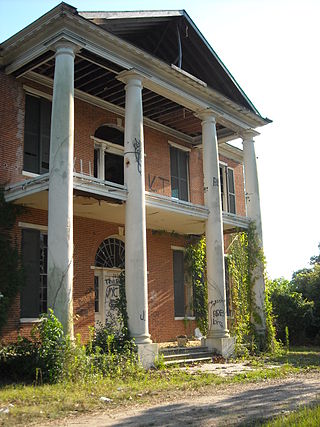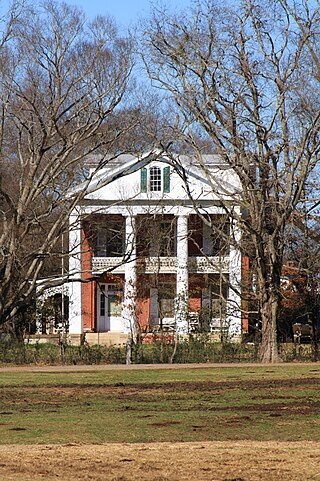
Cahaba, also spelled Cahawba, was the first permanent state capital of Alabama from 1820 to 1825, and the county seat of Dallas County, Alabama until 1866. Located at the confluence of the Alabama and Cahaba rivers, it suffered regular seasonal flooding.

Carpenter Gothic, also sometimes called Carpenter's Gothic or Rural Gothic, is a North American architectural style-designation for an application of Gothic Revival architectural detailing and picturesque massing applied to wooden structures built by house-carpenters. The abundance of North American timber and the carpenter-built vernacular architectures based upon it made a picturesque improvisation upon Gothic a natural evolution. Carpenter Gothic improvises upon features that were carved in stone in authentic Gothic architecture, whether original or in more scholarly revival styles; however, in the absence of the restraining influence of genuine Gothic structures, the style was freed to improvise and emphasize charm and quaintness rather than fidelity to received models. The genre received its impetus from the publication by Alexander Jackson Davis of Rural Residences and from detailed plans and elevations in publications by Andrew Jackson Downing.
A plantation house is the main house of a plantation, often a substantial farmhouse, which often serves as a symbol for the plantation as a whole. Plantation houses in the Southern United States and in other areas are known as quite grand and expensive architectural works today, though most were more utilitarian, working farmhouses.

The Crocheron–McDowall House is a Greek Revival-style house located in Bastrop, Texas, United States. The two-story house was built in 1857 for wealthy New York merchant Henry Crocheron and his wife Mary Ann Tipple. Crocheron wanted a home that displayed his wealth, and built it with the finest materials and architectural decorations available. After his death in 1874, his niece Mary Ann McDowall inherited the property. She was an accomplished musician in Bastrop and held music classes at the residence. During the late 1800s, the residence was the social and intellectual center of Bastrop, and hosted prominent guests from across the country. McDowall died in 1933 and the house was sold. Since then, the Crocheron–McDowall House has had several owners who have showed interest in preserving and restoring the property for its historical significance.

Gaineswood is a plantation house in Demopolis, Alabama, United States. It is the grandest plantation house ever built in Marengo County and is one of the most significant remaining examples of Greek Revival architecture in Alabama.

Arlington is a historic Federal style house and outbuildings in Natchez, Mississippi. The 55-acre (22 ha) property, which includes three contributing buildings, was listed on the National Register of Historic Places in 1973. It was further declared a National Historic Landmark in 1974. Following a fire that destroyed much of the main house, it was placed on Mississippi's 10 most endangered historic places for 2009 by the Mississippi Heritage Trust.

Natchez On-Top-of-the-Hill Historic District is a historic district in Natchez, Mississippi that was listed on the National Register of Historic Places in 1979.

Benjamin Church House is a Colonial Revival house at 1014 Hope Street in Bristol, Rhode Island, U.S.A. It opened in 1909 as the "Benjamin Church Home for Aged Men" as stipulated by Benjamin Church's will. Beginning in 1934, during the Great Depression, it admitted women. The house was closed in 1968 and became a National Register of Historic Places listing in 1971. The non-profit Benjamin Church Senior Center was incorporated in June 1972 and opened on September 1, 1972. It continues to operate as a senior center.
Richmond, also known as Warrenton, is an unincorporated community in Dallas County, Alabama, United States. Richmond gained its name from Richmond County, New York, the birthplace for several early settlers, most notably the Crocherons. Richmond has one site included on the National Register of Historic Places, the Street Manual Training School. Elm Bluff Plantation, owned by John Jay Crocheron, is nearby in Elm Bluff.

Magnolia Grove is a historic Greek Revival mansion in Greensboro, Alabama. The house was named for the 15-acre (6.1 ha) grove of Southern magnolias in which it stands. It was added to the National Register of Historic Places on April 11, 1973, due to its architectural and historical significance. It now serves as a historic house museum and is operated by the Alabama Historical Commission.

The Alfred Hatch Place at Arcola, also known as the Arcola Plantation and locally as the Half-house, is a historic plantation house and historic district on the Black Warrior River several miles northwest of Gallion, Alabama.

Fairhope Plantation is a historic Carpenter Gothic plantation house and historic district, located one mile east of Uniontown, Alabama, US. The 2+1⁄2-story wood-framed main house was built in the Gothic Revival style in the late 1850s. The plantation historic district includes six other contributing buildings, in addition to the main house. It was added to the Alabama Register of Landmarks and Heritage on December 19, 1991, and subsequently to the National Register of Historic Places on May 29, 1992, due to its architectural and historical significance.

The Blake Daniels Cottage is a historic house at 111–113 Elm Street in Stoneham, Massachusetts. Built in 1860, it is a good example of a Greek Revival worker's residence, with an older wing that may have housed the manufactory of shoe lasts. The house was listed on the National Register of Historic Places in 1984.

The Burn, a house built in 1834, is the oldest documented Greek Revival residence in Natchez, Mississippi. It was built on a knoll to the north of the old town area of Natchez. It was listed on the National Register of Historic Places in 1979.

Sturdivant Hall, also known as the Watts-Parkman-Gillman Home, is a historic Greek Revival mansion and house museum in Selma, Alabama, United States. Completed in 1856, it was designed by Thomas Helm Lee for Colonel Edward T. Watts. It was added to the National Register of Historic Places on January 18, 1973, due to its architectural significance. Edward Vason Jones, known for his architectural work on the interiors at the White House during the 1960s and 70s, called it one of the finest Greek Revival antebellum mansions in the Southeast.

Edward Martineau Perine was a merchant and planter in Cahaba, Alabama. Born at Southfield, Staten Island, New York, a son of Edward and Addra Guyon Perine, and a descendant of Daniel Perrin, "the Huguenot", Perine moved to Cahaba, Alabama in the early 1830s, where he became a wealthy merchant and plantation owner. As early as 1832, Perine entered business as a partner with Thomas Moreng and Richard Conner Crocheron in the firm of Thomas Moreng and Company. Following Moreng's death in 1835, the business was dissolved and replaced by the partnership of Perine and Crocheron. Their store was located on the corner of Vine and Second North Streets in Cahaba, directly opposite Bell's Hotel. In 1850 Perine bought Crocheron's interest in the business and the storehouse and in 1853 Perine sold his mercantile establishment to the partnership of Samuel M. Hill and John R. Sommerville. In 1856, he was once again in business, this time in partnership with Sommerville in the firm of E. M. Perine and Company. The partnership dissolved in 1858, with Sommerville continuing as a salesman for E. M. Perine and Company. In 1860 Perine was in partnership again, this time as Perine and Hunter. Anna M. Gayle Fry, writing in her book Memories of Old Cahaba, describes E. M. Perine as "a merchant prince of ante-bellum days, a Northern gentleman of the old school who was universally beloved by all who knew him." Following the Civil War, Perine's business at Cahaba was ruined, as his daughter Mary E. Perine Tucker put it, having "lost all".

Alpine is a historic plantation house in Alpine, Alabama, United States. Completed in 1858, the two-story Greek Revival-style house was built for Nathaniel Welch by a master builder, Almarion Devalco Bell. The wood-frame house has several unusual features that make it one of the more architecturally interesting antebellum houses in the state. These features include the foundation materials, interior floor-plan, and the window fenestration.

The Thacher-Goodale House is a historic house at 121 North Street in Saco, Maine. Built in 1827, it is a sophisticated early expression of Greek Revival architecture, retaining significant Federal period details. Built for George Thacher, Jr., a lawyer, it was owned for many years by members of the Goodale family, most notably the botanist George Lincoln Goodale. The house was listed on the National Register of Historic Places in 1976.

The James M. Jameson Farm is a farmstead located at 10220 North Parma Road near Springport, Michigan. It was listed on the National Register of Historic Places in 1980.
The Monk House, in Claiborne Parish, Louisiana near Homer, Louisiana, was built in 1855.





















